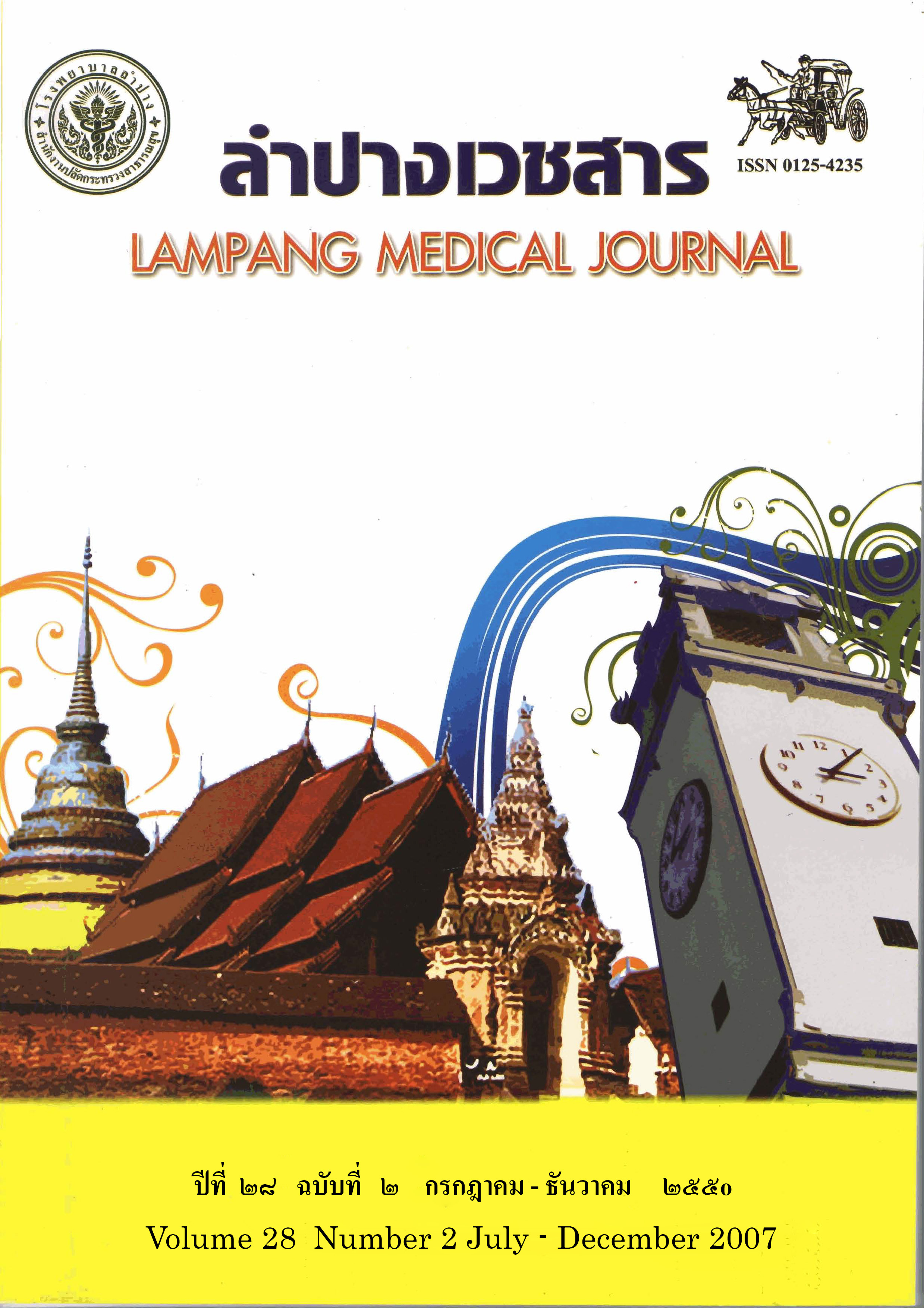Glucose, lipid and blood pressure control in type 2 diabetes
Main Article Content
Abstract
Diabetes is a chronic dieases and frequently associated with disorders of the eyes, kidney, nerves and atherosclerosis. The risk of these complications are mitigated by broad-based treatment of hyperglycemia, dyslipidemia and hypertension. This cross-sectional study was conducted on 1,856 type 2 diabetes mellitus at Lampang's diabetes clinic to assess the achievement of diabetes management according to the American Diabetes Association recommendation. For glucose control, 47.78% had HbA1c < 7%,and 35.67% had blood pressure<130/80 mmHg while for lipid, 47.78% had triglycerides<150 mg/dl, 46.82% had LDL cholesterol <100 mg/dl, 50.00% of men had HDL cholesterol>40 mg/dl and 36.76% of women had HDL cholesterol>50 mg/dl. Only 9.64% of diabetic patients achieved all of the targets of glucose, blood pressure and LDL, cholesterol, thus indicated that diabetes management required multidisciplinary team of health care providers with broad-based treatment covering all metabolic disorders in diabetes.
Diabetic education should provide to all diabetic patients for self diabetes management that might reduce risk of vascular complications and mortality.
Article Details

This work is licensed under a Creative Commons Attribution-NonCommercial-NoDerivatives 4.0 International License.
บทความที่ส่งมาลงพิมพ์ต้องไม่เคยพิมพ์หรือกำลังได้รับการพิจารณาตีพิมพ์ในวารสารอื่น เนื้อหาในบทความต้องเป็นผลงานของผู้นิพนธ์เอง ไม่ได้ลอกเลียนหรือตัดทอนจากบทความอื่น โดยไม่ได้รับอนุญาตหรือไม่ได้อ้างอิงอย่างเหมาะสม การแก้ไขหรือให้ข้อมูลเพิ่มเติมแก่กองบรรณาธิการ จะต้องเสร็จสิ้นเป็นที่เรียบร้อยก่อนจะได้รับพิจารณาตีพิมพ์ และบทความที่ตีพิมพ์แล้วเป็นสมบัติ ของลำปางเวชสาร
References
Buse JB, Ginsberg HN, Bakris GL, Clark NG, Costa F, et al. Primary prevention of cardiovascular diseases in people with diabetes mellitus. Diabetes Care 2007;30:162-72.
The Diabetes Control and Complication Trial Research Group. The effect of intensive treatment of diabetes on the development of long-term complications in insulin-dependent diabetes mellitus. N Engl J Med 1993; 329:977-86.
Laakso M, Kuusisto J. Epidemiological evidence for the association of hyperglycemia and atherosclerotic vascular disease in non-insulin- dependent diabetes mellitus. Ann Med 1996;28:415-8.
UK Prospective Diabetes Study Group (UKPDS). Effect of intensive blood glucose control with metformin on complications in overweight patients with 2 diabetes(UKPDS). Lancet 1998;352:854-65.
UKPDS. Intensive blood glucose control with sulphonylureas or insulin compared with conventional treatment and risks of complications in patients with type 2 diabetes (UKPDS33). UK Prospective Diabetes Study Group (UKPDS). Lancet 1998; 352:837-53.
Strattron I, Adler AL, Neil H, et al. Association of glycemia with macrovascular and microvascular complications of type 2 diabetes (UKPDS 35): prospective observational study. BMJ 2000;321:405-12.
Turner RC, Millns, Heil HA, et al. For the United Kingdom Prospective Diabeted Study Group. Risk factors for coronary artery disease in non-insulin-dependent diabetes mellitus: United Kingdom Prospective Diabetes Study Group (UKPDS 23). BMJ 1998;316:823-28.
Gaede P, Vedel P, Larsen N, et al. Multifactorial intervention and cardiovascular disease in patients with type 2 diabetes. N Eng J Med 2003;348:383-93.
Hafner SM, Lehto S, Ronnemaa T, Pyorala K, Laakso M. Mortally from coronary heart disease in subjects with type 2 diabetes
and in non diabetic subjects with and without prior myocardial infraction. N Engl J Med 1998;338:229-34.
American Diabetes Association: Standard of medical care in diabetes-2006. Diabetes Care 2006;29(Suppl.1):s4-42.
Alberti KGMM, Zimmet P, Shaw J, foe the IDF Epidemiology Task Force Consensus Group. The metabolic sysdrom anew
worldwide definition. Lancet 2005;366:1059-62.
Lindstrom J, Tuomilehto J, The diabetes risk score : a practical tool to predict type 2 diabetes risk. Diabetes Care 2003;26:725-31.
Canadian Diabetes Association Clinical Practice Guidlines Expert Commitee.
Canadian Diabetes Association 2003 Clinical Practice Guidelines for the Prevention and Management of Diabetes in Canada.
Can J Diabetes 2003;27(Suppl.2):1-140.
Waldon CE, Knopp RH, Wahl PW. Sex diffrences in the effect of diabetes mellitus on lipoprotein triglycerides and cholesterol concentrations.
N Engl J Med 1984;311:953-59.


